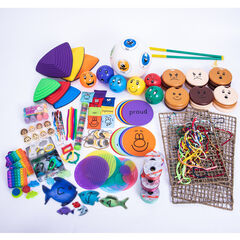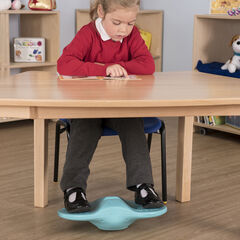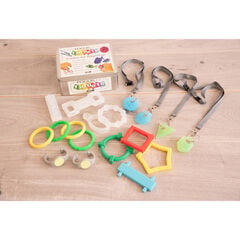Have you ever fancied a little cheeky snack whilst marking a class set of maths books but was not quite sure what the snack should be? Whenever this happens to me, I usually find myself raiding the fridge. This usually involves a delicate and scientific process of shovelling at least one large mouthful of just about everything available in the fridge into my mouth until I find the thing that satisfies my snacking urge. Although I get there in the end, there are drawbacks to this approach. The main one being that it is usually the last thing I eat that satisfies my snacking urge. This is not great because my fridge is usually full of food and results in a lot of unnecessary eating, frustration and disappointment whilst I explore and increase my calorie count to arrive a … ‘just the thing’. So how does this snack based analogy link to sensory resources?
Which sensory resources should we be using?
Often, in my advisory teacher capacity, I get asked about which sensory resources are needed to help pupils meet their own sensory needs. This conversation often centres around a pupil who is driving their class teachers bonkers because they fidget a lot or mess with resources when they should be sitting still, not touching and listening. Often, the school has already tried offering a sensory object that they can fiddle with during lessons, but things have not quite gone to plan.
School staff have found that:
- The child has stopped using the prescribed sensory object and the unwanted behaviours have become worse.
- The sensory object worked initially but appears to have stopped working now – sometimes it has turned into something to throw!
- Everyone is a little more frustrated as nothing has changed.
When we give a child a sensory resource we always do it from a good place. We want to give the pupil something that will help them to regulate their sensory needs so that they are able to access learning. If it works well everyone, including the child’s class, teacher feels better – case solved! However, for many reasons such as resource budget, time constraints, resource availability and perhaps a limited understanding of what the deeper need that the pupil is trying to meet is, we have a one size fits all approach. We give a generic resource such as a tangle. The pupil initially likes it, but soon the novelty wears off, the pupil stops using it and nothing is different.
So, what do we do?
The answer lies in allowing the pupil to metaphorically raid the fridge.
Here are some things to reflect upon that will help you to help your pupils achieve the right balance and get the most from the sensory resources that we provide:
- We need to understand what underlying need the pupil is attempting to satisfy with a potentially sensory based behaviour. Talk to the pupil to gain an understanding of their needs and explore when and where the sensory behaviours take place. Look for patterns and triggers. For example, if the pupil is constantly fiddling with something, perhaps fidgeting, tapping or making their own noises, could this be a way of keeping their body busy so that they can concentrate on the teacher’s instructions?
- What are we trying to achieve from the introduction of a sensory resource? What do you and the pupil want to be different? How do they want to feel when they use the resource?
- It is important to develop a hypothesis in partnership with the pupil and test this. Provide a range of sensory resources that might meet the pupil’s sensory need. Reflect upon what we learn from the introduction and impact of each resource. Are things better or worse? What does the pupil seem to prefer?
- Consider timing. When is a good time for the pupil to use that resource so that it has the greatest impact?
- Provide variety and choice so that the ‘novelty’ factor can be utilised to encourage use.
And finally …
The most important thing to remember is to let the pupil ‘raid the fridge’. Ask them to experiment with different options to find what works best for them and when to use it. Be willing to try out a number of different types of the same resource. After all, we may like a cheeky nibble on a slice of cheese but, on some days and we may not know it at the time, only a slice of ham will do!
A huge thank you to Beccie Hawes for writing this blog for us.
About Beccie Hawes
Beccie has worked in all aspects of Special Educational Needs including mainstream, additionally resourced provision and specialist settings. She has extensive experience as a SENCo, Inclusion Manager, Lead Local Authority SEND Advisory Teacher and has set up and led an inclusion advisory service.
Beccie is currently proud to be the Head of Service with Cadmus Inclusive, part of Cadmus Services, which is based in Walsall. This service has a national reach and actively supports schools with all aspects of providing a high quality education for vulnerable learners. Beccie is the author of ‘The Complete Dyslexia Toolkit’ and co-author of ‘Getting it Right for SEND’ and ‘How to Create the Perfect Partnership with Parents’. Beccie also writes the national Ebriefing: SEND Bitesize. She has developed a number of educational resources to support learners which schools across the UK have purchased and use. Beccie remains very ‘hands on’ in the classroom and is passionate about being at the chalk face to support teachers and children to think differently for a brighter tomorrow. She is also the mum to four boys and a dog.











